Planning circular 1/2024: householder permitted development rights
Guidance on householder permitted development rights (PDR). It explains what works people can carry out to alter or improve their home without an application for planning permission.
4. Making changes to a dwellinghouse
4.1 This section explains the PDR for “dwellinghouses”. In this context, a dwellinghouse means a residential property, not including a building containing one or more flats, or a flat contained within such a building. The term ‘dwellinghouse’ covers detached, semi-detached or terraced houses. PDR for flats is explained in section 5.
4.2 This section covers various types of development and is structured as follows:
- Single storey ground floor extensions (Class 1A)
- Ground floor extensions of more than one storey (Class 1B)
- Porches (Class 1C)
- Roof enlargements (Class 1D)
4.2 Improvements, additions or other alterations that are not enlargements
- Access ramps (Class 2A)
- Improvements or alterations within a “1 metre bubble” (Class 2B)
4.3 Development within the curtilage of a dwellinghouse
- Ancillary buildings such as sheds, garages, greenhouses (Class 3A)
- Storage buildings of limited dimensions e.g. bike sheds (Class 3AA)
- Building, engineering, installation or other operations (Class 3B)
- Hard surfaces (Class 3C)
- Decking (Class 3D)
- Gates, fences and walls (Class 3E)
4.1 Enlarging a dwellinghouse
4.3 It is important to understand the definition of enlargement. Enlargement is defined as any development that increases the internal volume of the original dwellinghouse and includes a canopy or roof, with or without walls, which is attached to the dwellinghouse, but does not include a balcony. Therefore, a car-port is an enlargement but a balcony is not.
4.4 There are many types of enlargements to dwellinghouses. Section 4.1 of this guidance covers:
- Single storey ground floor extensions (Class 1A)
- Ground floor extensions of more than one storey (Class 1B)
- Porches (Class 1C)
- Roof enlargements (Class 1D)
Single storey ground floor extensions (Class 1A)
Summary
4.5 This is the most common type of enlargement to a dwellinghouse. Class 1A PDR allow the enlargement of a dwellinghouse by a single storey ground floor extension. The PDR allow any alteration to the roof required for the purpose of the enlargement. In summary, the effect of the limitations is that:
- extensions are generally located to the rear.
- if the extension is on, or within 1 metre of the boundary, it cannot project, from the rear wall of the existing dwellinghouse, by more than 3 metres in the case of terraced house, or 4 metres in all other cases.
- the height of the eaves is a maximum of 3 metres.
- the height of the extension is not higher than 4 metres.
- the footprint of the extension is no larger than the original dwellinghouse or covering more than half the relevant (front or rear) curtilage – please see paragraphs 3.22 to 3.25).
4.6 Where the conditions and limits set out in Class 1A would not be complied with, an application for planning permission would be required.
4.7 There are no PDR for single storey ground floor extensions in conservation areas or for flats. Nor are there any PDR for ground floor extensions for a dwellinghouse created by Class 18B or 22A (i.e. conversion of agricultural or forestry building). Listed building consent will normally be required if your building is listed.
4.8 A building warrant from the local authority will likely be required for this type of extension, as explained in section 2.
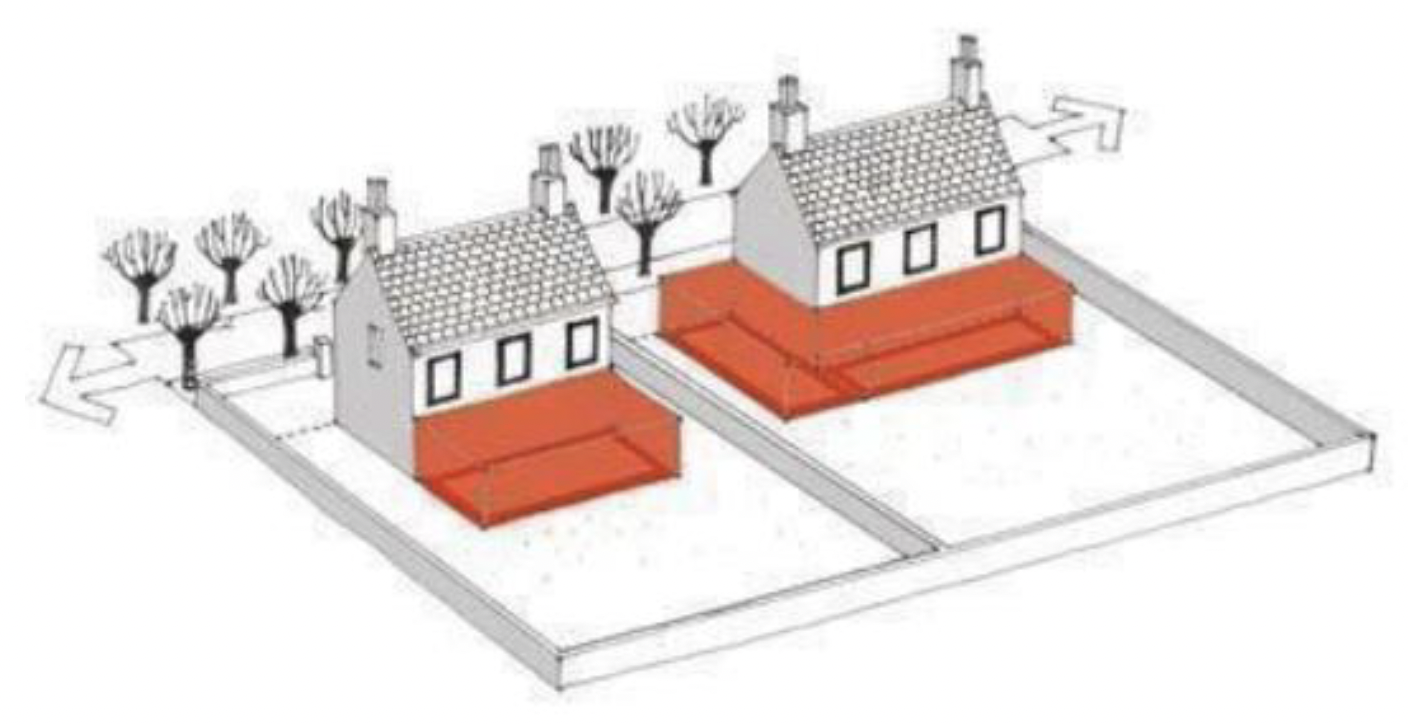
4.9 Roof alterations relating to the extension are also permitted. Other roof alterations should be carried out using the other relevant permitted development classes.
4.10 The extension cannot be forward of a wall forming part of the principal elevation or side elevation if that elevation is fronting a road. The identification of the principal elevation and side elevations are discussed in section 3 of this guidance, as is the concept of fronting a road. This is illustrated in figure 13.
4.11 Figure 13: The shaded areas of the curtilage indicate where a single storey extension is permitted as long as the other limitations are met.

4.12 If any part of the extension is within 1 metre of the boundary of the curtilage, then for a terraced house it can only project from the line of the rear elevation nearest to the boundary by up to 3 metres or 4 metres in any other case.
4.13 This restriction does not apply to a side extension that does not project beyond the line of the rear elevation. For example, if a side extension does extend beyond the line of the rear wall [and is within 1 metre of the rear wall] and is within 1 metre of the boundary, then it cannot project from the rear wall nearest the boundary by more than 3 metres if a terraced house or 4 metres in any another case.
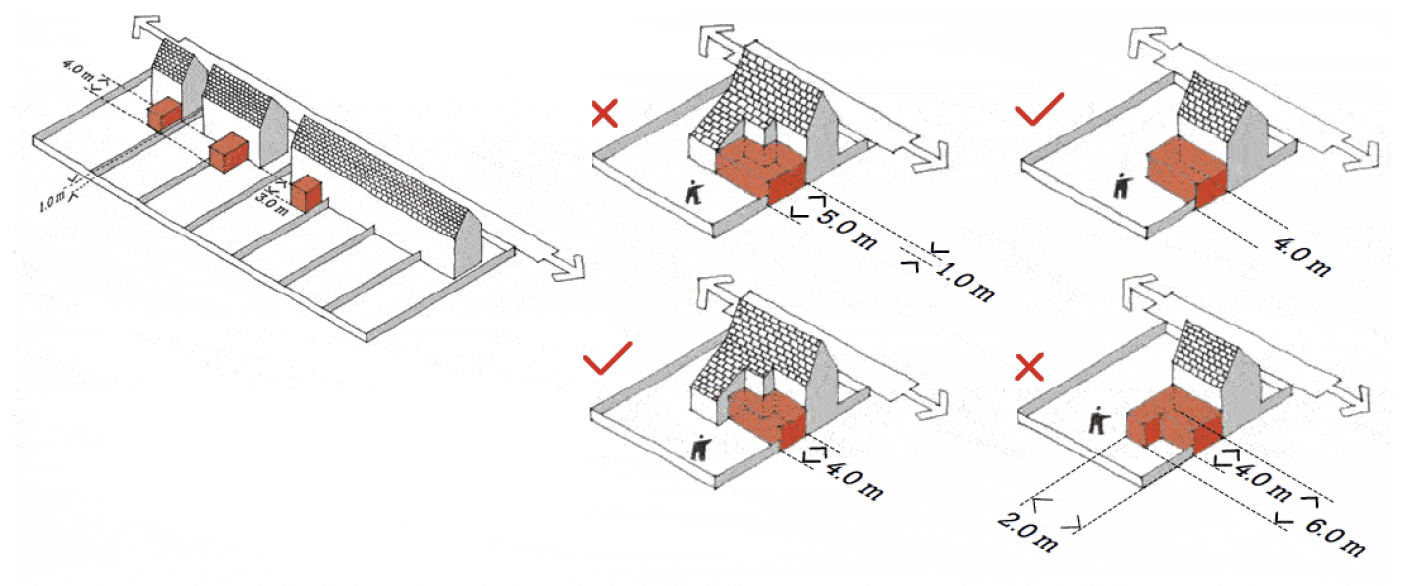
4.14 The overall height of an extension can have a significant impact on neighbours. The eaves of the extension cannot be higher than 3 metres. The overall height of the extension cannot exceed 4 metres.
4.15 When measuring the height of the extension on sloping, or uneven ground, the height should be measured from the lowest point immediately adjacent to the extension.
4.16 The area covered by all extensions, including any existing and the proposed extension, cannot be greater than the footprint of the original dwellinghouse. This is to ensure that the extension (including previous extensions) is in proportion to the original dwellinghouse.
4.17 The proposed extension (including previous extensions) and existing developments cannot exceed half of the of the rear (or front if appropriate) curtilage of the original dwellinghouse. This is explained further in section 3 of this guidance.
4.18 There are no Class 1A PDR in a conservation area or for flats or for dwellinghouses created by Class 18B or 22A (i.e. conversion of an agricultural or forestry building). Listed building consent is required if the proposed extension affects the character of a listed building.
4.19 Planning authorities will be able to confirm whether a property is located within a conservation area. Information on listed buildings is available on Historic Environment Scotland’s website.
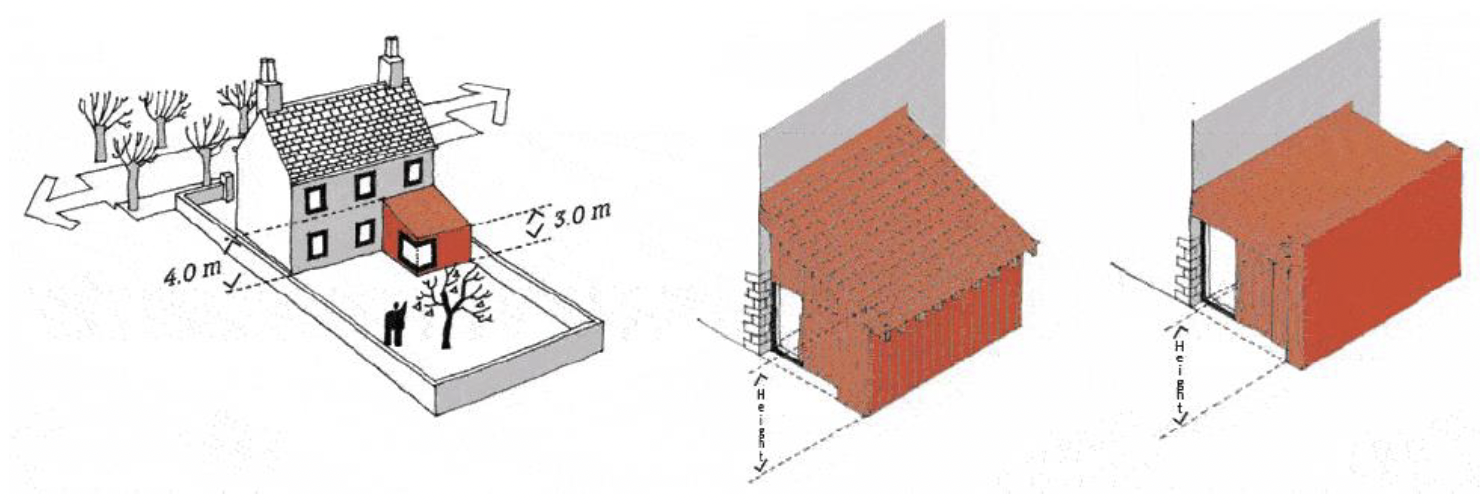
Legislation
Class 1A.-
(1) Any enlargement of a dwellinghouse by way of a single storey ground floor extension, including any alteration to the roof required for the purpose of the enlargement.
Development is not permitted by this class if-
(za) the dwellinghouse is a dwelling by virtue of a change of use permitted under Class 18B or 22A;
(a) any part of the development would be forward of a wall forming part of the principal elevation or side elevation where that elevation fronts a road;
(b) any part of the development would be within 1 metre of the boundary of the curtilage of the dwellinghouse and it would extend beyond the line of the wall forming part of the rear elevation that is nearest that boundary by more than—
(i) 3 metres in the case of a terrace house; or
(ii) 4 metres in any other case;
(c) the height of the eaves of the development would exceed 3 metres;
(d) any part of the development would exceed 4 metres in height;
(e) as a result of the development the area of ground covered by the resulting dwellinghouse would be more than twice the area of ground covered by the original dwellinghouse;
(f) as a result of the development the area of ground covered by development within the front or rear curtilage of the dwellinghouse (excluding the original dwellinghouse and any hard surface or deck) would exceed 50% of the area of the front or rear curtilage respectively (excluding the ground area of the original dwellinghouse and any hard surface or deck); or
(g) it would be within a conservation area.
Ground floor extension of more than a one storey (Class 1B)
Summary
4.20 Permitted development rights in Class 1B allow the enlargement of a dwellinghouse by the way of a ground floor extension consisting of more than one storey. The PDR also allow any alteration to the roof required for the purpose of the enlargement. In summary, the effect of the limitations is that:
- extensions are generally located to the rear
- the distance between the extension and any boundary is a minimum of 10 metres
- the height of the extension is not higher than the existing dwellinghouse
- the footprint of the extension is not larger than the original dwellinghouse or covering more than half the relevant (front or rear) curtilage – please see paragraphs 3.22 to 3.25.
4.21 Where the conditions and limits set out in Class 1B would not be complied with, an application for planning permission would be required.
4.22 There are no PDR in conservation areas or for flats. Nor are there any PDR for ground floor extensions for a dwellinghouse created by Class 18B or 22A (i.e. conversion of an agricultural or forestry building). Listed building consent will normally be required if your building is listed.
4.23 A building warrant from the local authority will be required for this type of extension, as explained in section 2.
Technical Explanation
4.24 The extension cannot be forward of a wall forming part of the principal elevation or side elevation if that elevation is fronting a road. The identification of the principal elevation and side elevations are discussed in section 3 of this guidance, as is the concept of fronting a road. This is illustrated in figure 14 below.
4.25 Figure 14: The shaded areas of the curtilage indicate where an extension of more than a single storey is permitted as long as the other limitations are met.
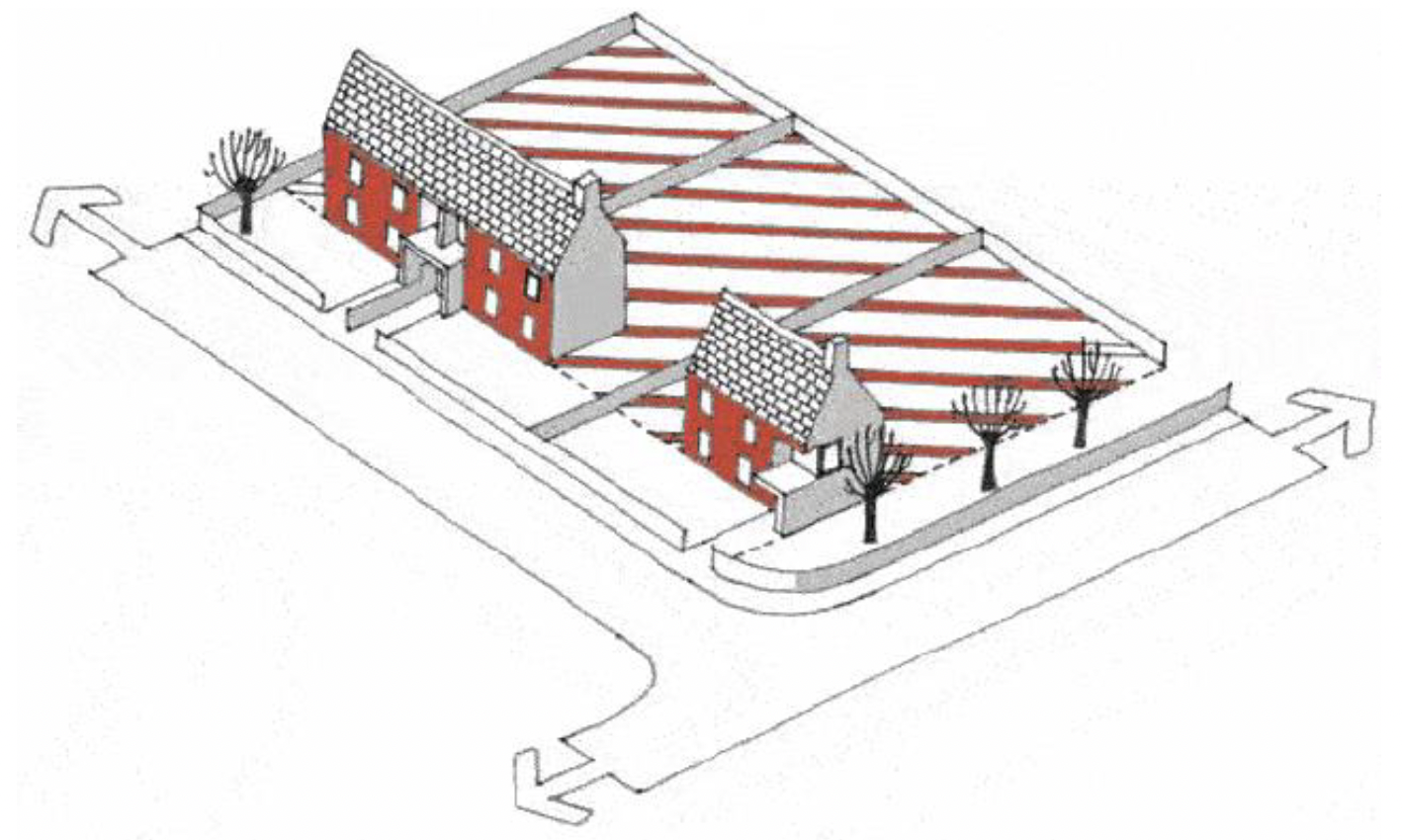
4.26 1½ storey or 2 storey extensions are more likely to have a visual impact, potentially causing overshadowing or overlooking. No part of the extension can therefore be within 10 metres of any boundary of the curtilage.
4.27 The overall height of the extension cannot be higher than the existing roof. This would be the ridge of the roof. Roof alterations relating to the extension are also permitted. Other roof alterations should be carried out using the other relevant classes.
4.28 The area covered by all extensions, including any existing and the proposed extension, cannot be greater than the footprint of the original dwellinghouse. This is to ensure that the extension (including previous extensions) is in proportion to the original dwellinghouse.
4.29 The proposed extension (including previous extensions) and existing developments cannot exceed half of the rear (or front if appropriate) curtilage of the original dwellinghouse. This is explained further in section 3 of this guidance.
4.30 There are no Class 1B PDR in a conservation area or for flats or for dwellinghouses created by Class 18B or 22A (i.e. conversion of an agricultural or forestry building). A listed building consent is required if the proposed extension affects the character of a listed building.
4.31 Planning authorities will be able to confirm whether a property is located within a conservation area. Information on listed buildings is available on Historic Environment Scotland’s website.
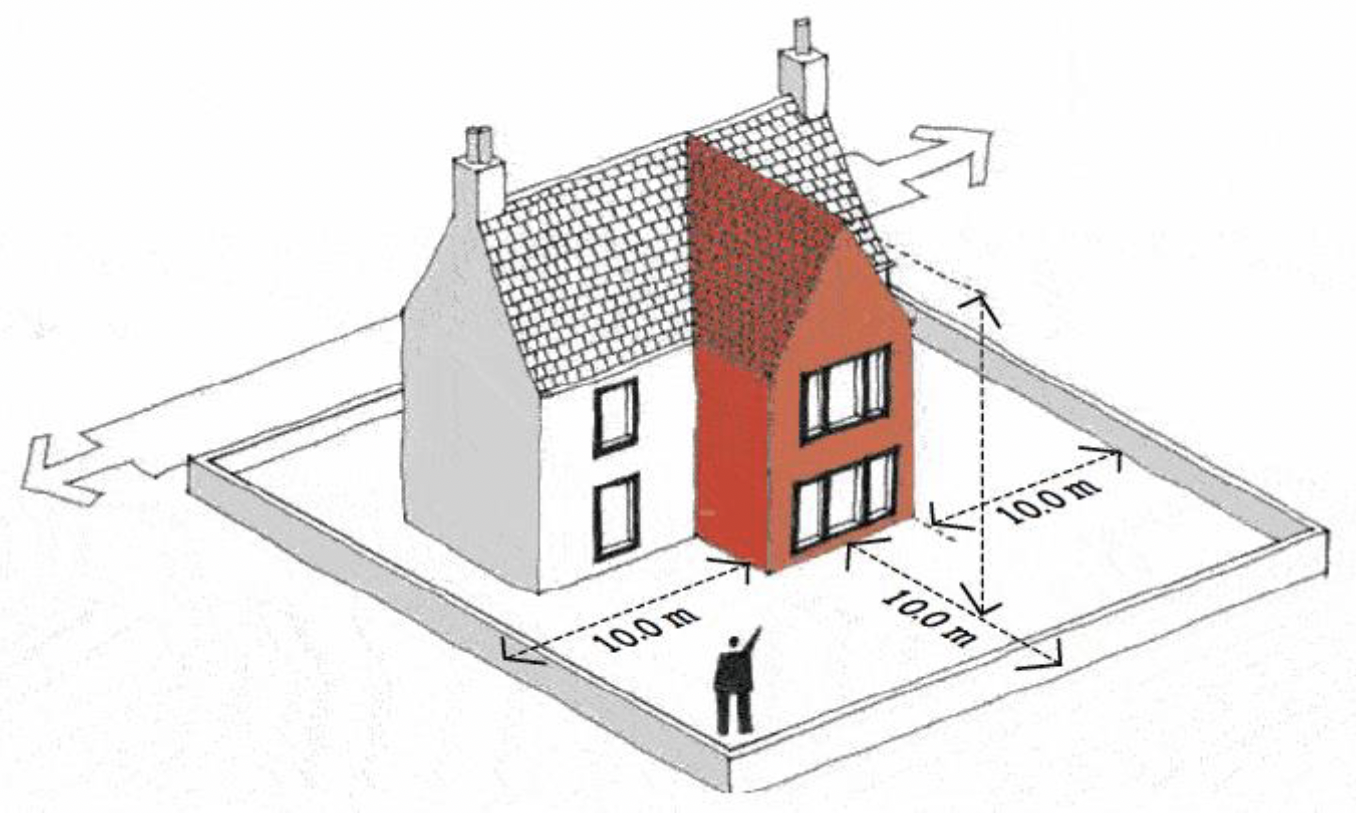
Legislation
Class 1B.-
(1) Any enlargement of a dwellinghouse by way of a ground floor extension consisting of more than one storey, including any alteration to the roof required for the purpose of the enlargement.
Development is not permitted by this class if-
(za) the dwellinghouse is a dwelling by virtue of a change of use permitted under Class 18B or 22A;
(a) any part of the development would be forward of a wall forming part of the principal elevation or side elevation where that elevation fronts a road;
(b) any part of the development would be within 10 metres of the boundary of the curtilage of the dwellinghouse;
(c) as a result of the development the height of the dwellinghouse would exceed the height of the existing dwellinghouse, when measured at the highest part of the roof and excluding any chimney;
(d) as a result of the development the area of ground covered by the resulting dwellinghouse would be more than twice the area of ground covered by the original dwellinghouse;
(e) as a result of the development the area of ground covered by development within the front or rear curtilage of the dwellinghouse (excluding the original dwellinghouse and any hard surface or deck) would exceed 50% of the area of the front or rear curtilage respectively (excluding the ground area of the original dwellinghouse and any hard surface or deck); or
(f) it would be within a conservation area.
Porches (Class 1C)
4.32 PDR allow the erection, construction or alteration of any porch outside any external door of a dwellinghouse. The limitations are:
- the porch cannot have a footprint of greater than 3 square metres.
- the minimum distance between the porch and any boundary and a road is more than 2 metres.
- the height of the porch cannot be higher than 3 metres.
4.33 If the porch exceeds any of the above limits, then an application for planning permission is required.
4.34 There are no PDR for porches in a conservation area or for a flat or for dwellinghouses created by Class 18B or 22A (i.e. conversion of an agricultural or forestry building). A listed building consent is required if the proposed extension affects the character of a listed building.
4.35 Planning authorities will be able to confirm whether a property is located within a conservation area. Information on listed buildings is available on Historic Environment Scotland’s website.
4.36 A building warrant from the local authority may be required for porches, as explained in section 2.
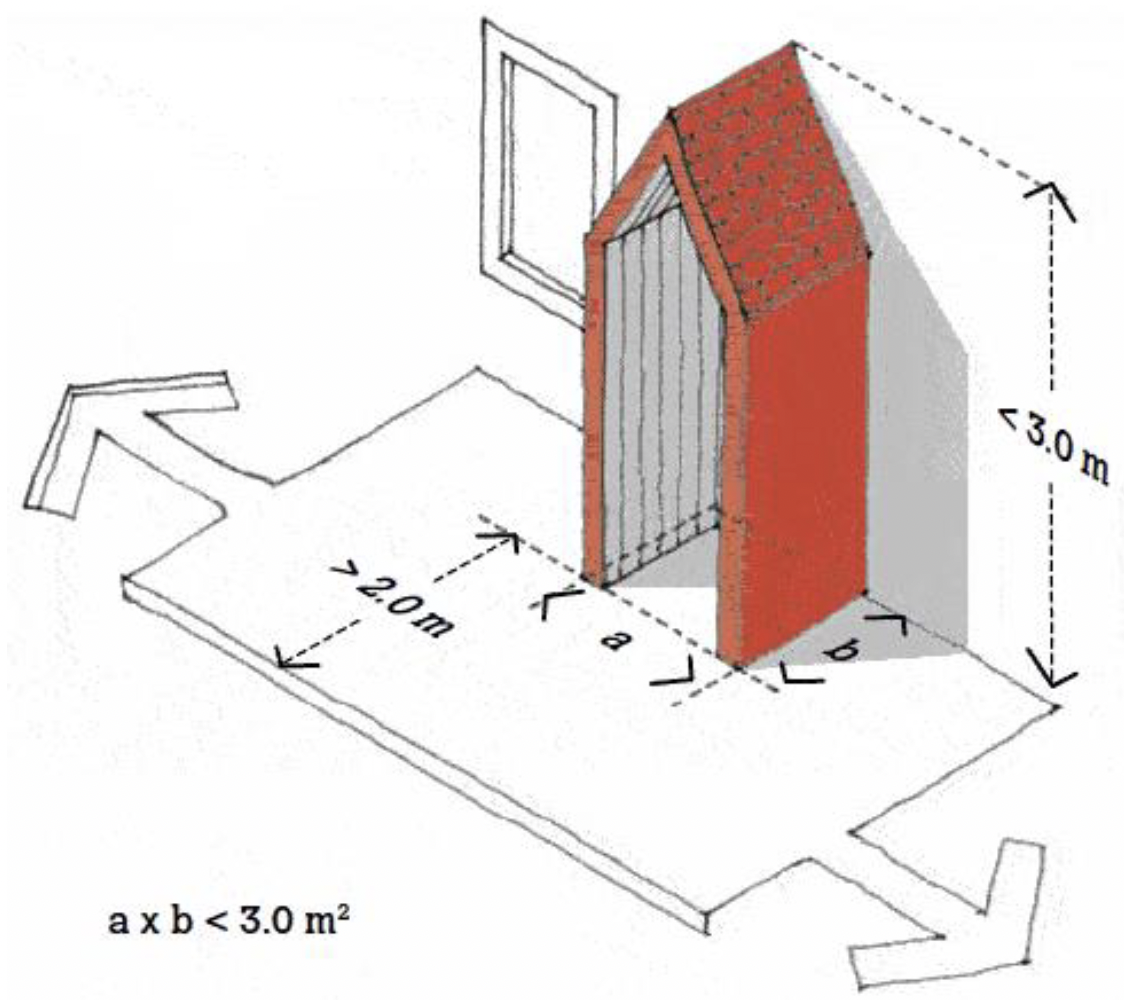
Legislation
Class 1C.-
(1) The erection, construction or alteration of any porch outside any external door of a dwellinghouse.
Development is not permitted by this class if-
(za) the dwellinghouse is a dwelling by virtue of a change of use permitted under Class 18B or 22A;
(a) its footprint would exceed 3 square metres;
(b) any part of it would be within 2 metres of a boundary between the curtilage of the dwellinghouse and a road;
(c) any part of the development would exceed 3 metres in height; or
(d) it would be within a conservation area.
Enlargement of the roof (Class 1D)
Summary
4.37 Class 1D PDR allow the enlargement of a dwellinghouse by way of an addition or alteration to its roof. This class typically relates to the addition of a dormer. A badly designed dormer can harm the appearance of a dwellinghouse. The larger the dormer, the more challenging it is to produce a good design. In summary, the effect of the limitations is that:
- dormers are generally located to the rear.
- the distance between the dormer and boundary it fronts is a minimum of 10 metres.
- the height of the dormer is not higher than the existing dwellinghouse.
- the dormer, or dormers, covers less than half the roof.
- the distance between the dormer and the edge of the roof is a minimum of 0.3 metres.
4.38 If the development exceeds any of the above limits, then an application for planning permission is required.
4.39 There are no PDR to enlarge a roof in a conservation area or a flat or for dwellinghouses created by Class 18B or 22A. (i.e. conversion of an agricultural or forestry building). Listed building consent will normally be required if your building is listed. Building standards may apply and a building warrant from the local authority may be required for this type of development as explained in section 2.
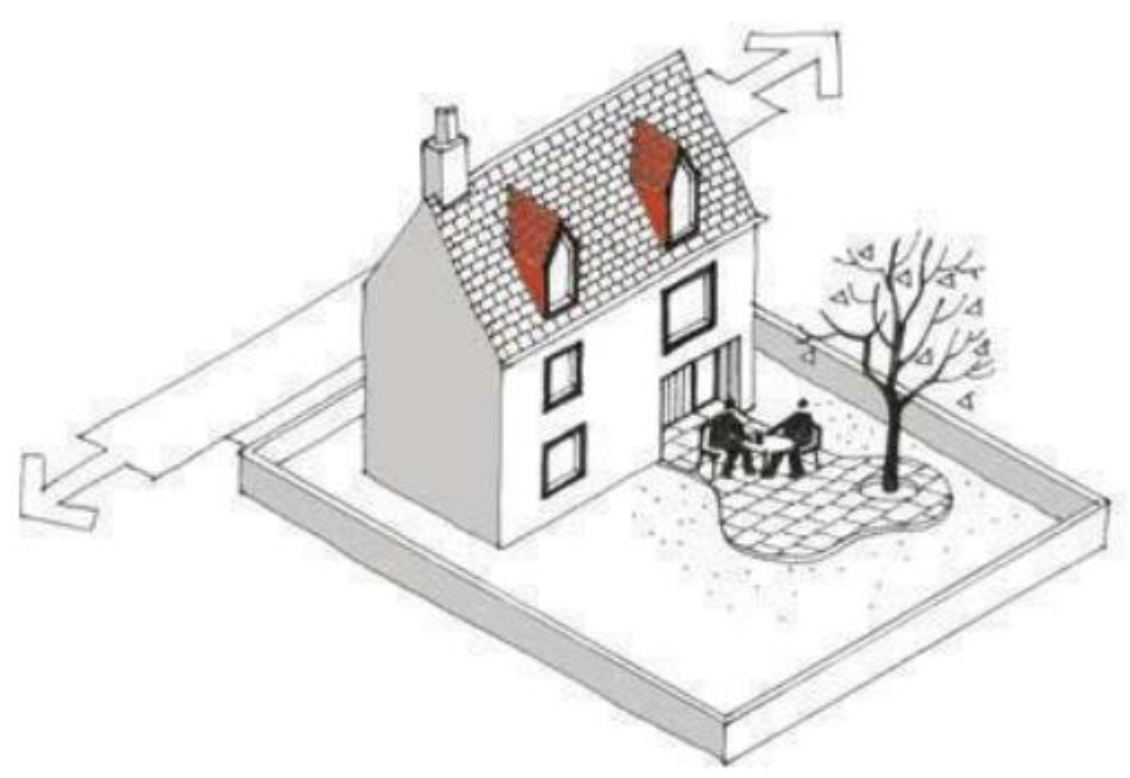
Technical Explanation
4.40 There are no PDR in a conservation area or for flats or for dwellinghouses created by Class 18B or 22A (i.e. conversion of an agricultural or forestry building). A listed building consent is required if the proposed development affects the character of a listed building. Planning authorities will be able to confirm whether a property is located within a conservation area. Information on listed buildings is available on Historic Environment Scotland’s website.
4.41 The development cannot be part of the roof forming the principal elevation or side elevation if that elevation is fronting a road. The identification of the principal elevation and side elevations are discussed in section 3 of this guidance, as is the concept of fronting a road.
4.42 Any enlargement or alteration to a roof is likely to have a visual impact and potentially cause overlooking. The development must be at least 10 metres from the boundary that it fronts.
4.43 The dormer must not exceed half the width of the roof plane (the width of the roof plane is measured at the eaves line). The development must be at least 0.3 metres from the edge of the roof plane, for example the ridge of the roof or the edge of a hipped roof. The overall height of the dwellinghouse cannot be increased as a result of the development. This is measured against the existing ridge of the roof.
4.44 Figure 15 illustrates the restrictions for a dormer, the highlighted areas indicate where the development is not permitted as long as the other limitations are met.
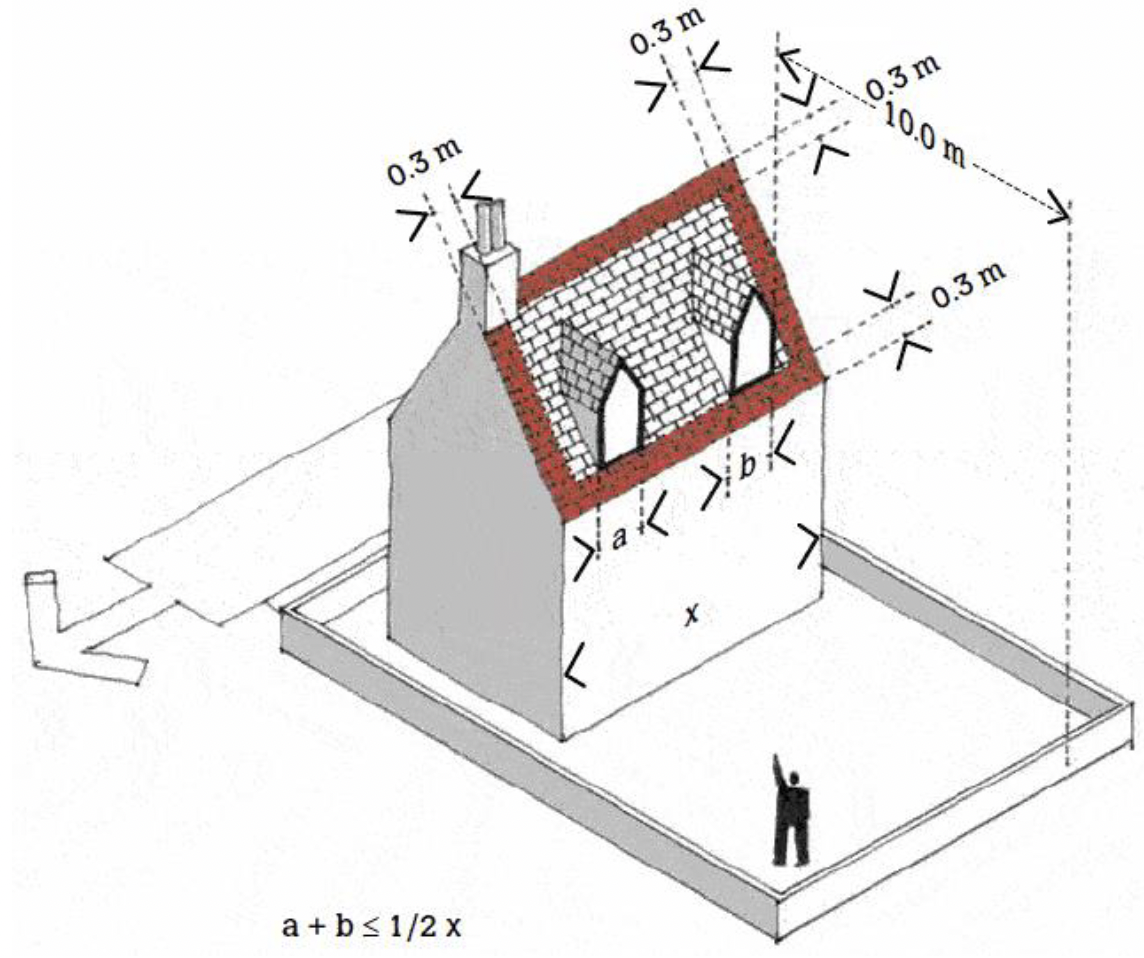
Legislation
Class 1D.-
(1) Any enlargement of a dwellinghouse by way of an addition or alteration to its roof.
Development is not permitted by this class if-
(za) the dwellinghouse is a dwelling by virtue of a change of use permitted under Class 18B or 22A;
(a) it would be on a roof plane forming part of the principal elevation or side elevation where that elevation fronts a road;
(b) it would be on a roof plane and would be within 10 metres of the boundary of the curtilage of the dwellinghouse which that roof plane fronts;
(c) as a result of the development the height of the dwellinghouse would exceed the height of the existing dwellinghouse, when measured at the highest part of the roof and excluding any chimney;
(d) its width would exceed half the total width of the roof plane, measured at the eaves line, of the dwellinghouse;
(e) any part of the development would be within 0.3 metres of any edge of the roof plane of the dwellinghouse; or
(f) it would be within a conservation area.
4.2 Improvements, additions or other alterations that are not enlargements
4.45 There are a variety of alterations or improvements to a dwellinghouse that are not enlargement. This section covers:
- Access Ramps (Class 2A)
- Improvements or alterations within a “1 metre bubble” (Class 2B)
4.46 Other common alterations or improvements that are not enlargements (e.g. installation of replacement windows, solar panels) are covered by their own specific PDR and are explained elsewhere in this document. For guidance on replacement windows, please see section 7 of this document; for guidance on the installation of domestic renewables equipment, please see section 6.
Access Ramps (Class 2A)
4.47 Class 2A PDR allow small ramps to be attached to the external door of a dwellinghouse so long as certain limitations are met. The limitations are:
- the length of all flights cannot be more than 5 metres.
- the length of all flights and landings cannot be more than 9 metres.
- the height of the access ramp, including associated handrails, cannot be higher than 1.5 metres.
- the height of the platform cannot be higher than 0.4 metres.
4.48 If the access ramp exceeds any of the above limits, or is in a conservation area, or within the curtilage of a listed building, then an application for planning permission is required. Listed building consent is required if the proposed access ramp affects the character of a listed building.
4.49 Supporting guidance, including information on suitable gradients and lengths of ramp, can be found in the Building standards technical handbook.
4.50 Planning authorities will be able to confirm whether a property is located within a conservation area. Information on listed buildings is available on Historic Environment Scotland’s website.
4.51 When measuring the height of the development on sloping or uneven ground, the height should be measured from the lowest point immediately adjacent to the ramp.
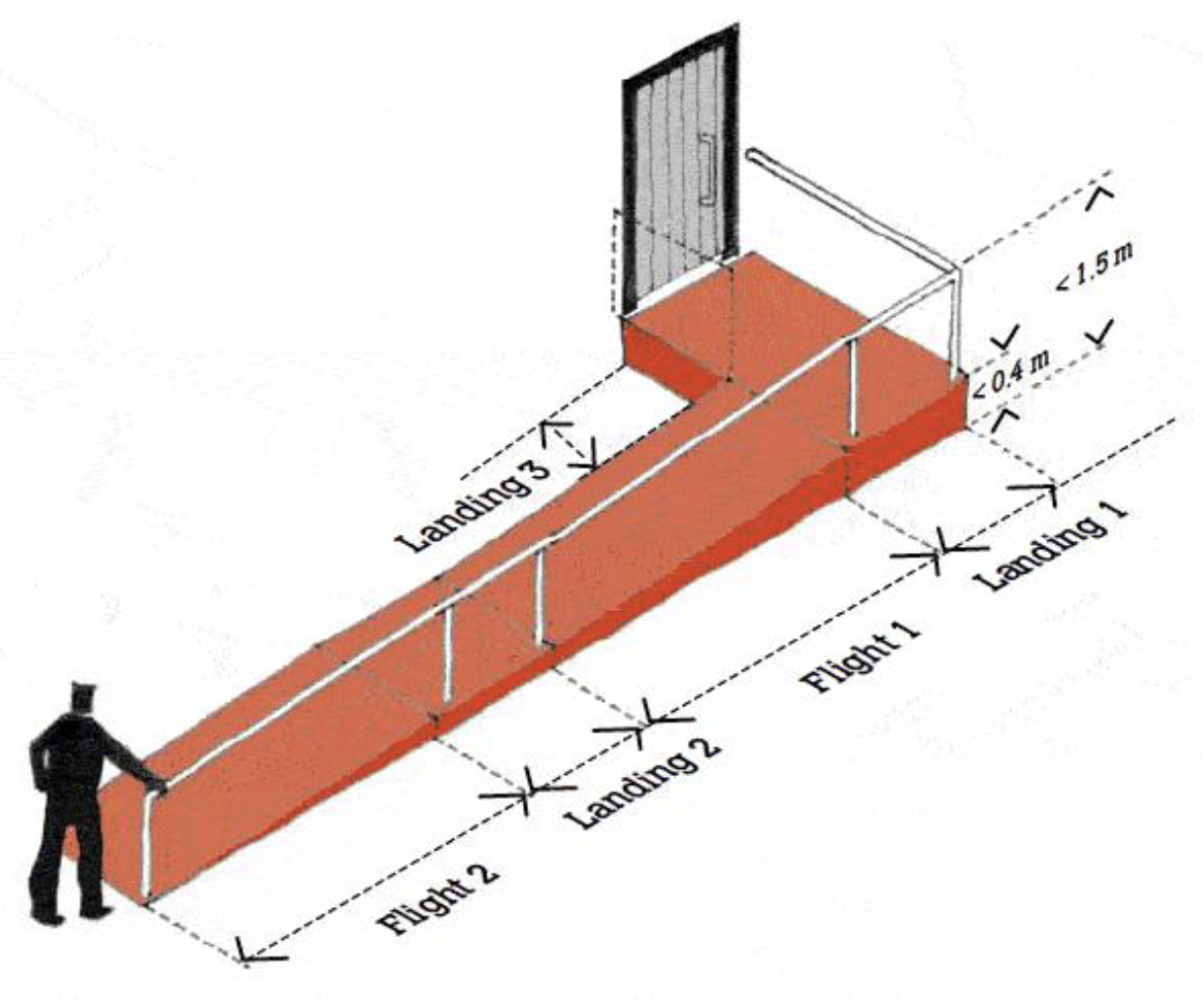
Legislation
Class 2A.-
(1) The erection, construction or alteration of any access ramp outside an external door of a dwellinghouse.
(2) Development is not permitted by this class if-
(a) the combined length of all flights forming part of the access ramp would exceed 5 metres;
(b) the combined length of all flights and landings forming part of the access ramp would exceed 9 metres;
(c) any part of the ramp would exceed 0.4 metres in height;
(d) the combined height of the ramp and any wall (excluding any external wall of the dwellinghouse), fence, balustrade, handrail or other structure attached to it would exceed 1.5 metres; or
(e) it would be within a conservation area or within the curtilage of a listed building.
Improvements or alterations within a “1 metre bubble” (Class 2B)
4.52 Class 2B PDR allow any improvement, addition or other alteration to the external appearance of a dwellinghouse that is not an enlargement. The development must not project by more than 1 metre from the wall or roof.
This is best visualised as a 1 metre bubble surrounding the dwellinghouse. A householder can therefore carry out a wide range of different types of development without having to apply for planning permission.
4.53 The development must not enlarge the dwellinghouse. This means that the development cannot increase the internal volume of the original building. This includes a canopy or roof, with or without wall, which is attached to the building but does not include a balcony.
4.54 The following types of development are not permitted by this class:
- balcony, roof terrace or raised platform
- wind turbine
4.55 The following developments are also not permitted by Class 2B because they are permitted by other classes:
- access ramps (Class 2A)
- a range of building or engineering operations including garden works, oil tanks (Class 3B)
- a flue forming part of biomass heating system (Class 6C)
- flue forming part of combined heat and power system (Class 6F)
- air source heat pumps (Class 6H)
- solar panels (Class 6HA and Class 6HB)
- wind turbines mounted on detached dwellinghouses (Class 6HC)
- alteration/ replacement windows (Class 7A)
- Close circuit television (CCTV) cameras (Class 72)
4.56 To ensure that the general character of an area is maintained, there is a condition that materials used for any roof covering must be similar in appearance to the existing roof.
4.57 An alteration to the external appearance would allow the painting (or repainting) of the property. It would also allow the painting or attaching of an advertisement to the property. While an application for planning permission may not be required by virtue of this class, an application for advertisement consent may be required under the Town and Country Planning (Control of Advertisements) (Scotland) Regulations 1984 depending on the nature and size of any such advertisement.
4.58 There are no Class 2B PDR in a conservation area. Listed building consent is required if the proposed development affects the character of a listed building. Planning authorities will be able to confirm whether a property is located within a conservation area. Information on listed buildings is available on Historic Environment Scotland’s website.
Legislation
Class 2B.-
(1)Any improvement, addition or other alteration to the external appearance of a dwellinghouse that is not an enlargement.
Development is not permitted by this class if-
(a) it would protrude more than 1 metre from the outer surface of an external wall, roof plane, roof ridge or chimney of the dwellinghouse;
(b) it would be a wind turbine;
(c) it would be a balcony;
(d) it would be on the roof and would result in a raised platform or terrace;
(e) it would be within a conservation area; or
(f) it would be development described in Class 2A(1), 3B(1), 6C(1), 6F(1), 6H(1), 6HA(1), 6HB(1), 6HC(1), 7A(1), 67(1) or 72(1).
(3) Development is permitted by this class subject to the condition that the materials used for any roof covering must be as similar in appearance to the existing roof covering as is reasonably practicable.
4.3 Development within the curtilage of a dwellinghouse
4.59 There are many other types of developments that can happen within the curtilage of dwellinghouse. The following classes are covered in this section:
- Ancillary buildings including sheds, garages, greenhouses (Class 3A)
- Storage buildings of limited dimensions e.g. bike sheds (Class 3AA)
- Building, engineering, installation or other operations (Class 3B)
- Hard surfaces (Class 3C)
- Decking (Class 3D)
- Gates, fences and walls (Class 3E)
Ancillary buildings including sheds, garages, greenhouses (Class 3A)
4.60 Class 3A PDR allow for the provision of any building that is incidental to the enjoyment of the dwellinghouse if it is in the curtilage. Typical developments include sheds, garages, sun-houses and greenhouses. In summary, the key limitations are that:
- buildings are generally located to the rear
- at least half the relevant (front or rear) curtilage must remain undeveloped – see paragraphs 3.22 to 3.25.
- the height of the building may not exceed 4 metres
- parts of the building within 1 metre of the curtilage boundary may not be higher than 2.5 metres
- the height of the eaves may not exceed 3 metres
- the building cannot be used as a separate dwelling
4.61 In the case of dwellinghouses in a conservation area development is permitted development as long as the footprint of the ancillary building does not exceed 8 square metres (4 square metres if within the curtilage of a listed building). Listed building consent is required if the proposed development affects the character of a listed building. A building warrant from the local authority may be required for these types of developments, as explained in section 2.
4.62 The building cannot be forward of a wall forming part of the principal elevation or side elevation if that elevation is fronting a road. The identification of the principal elevation and side elevations are discussed in section 3 of this guidance, as is the concept of fronting a road. This is illustrated below; the shaded areas of the curtilage indicate where an ancillary building is permitted as long as the other limitations are met.

4.63 The parts of the building within 1 metre of a boundary must not be higher than 2.5 metres as illustrated below.

4.64 When measuring the height of the development on sloping or uneven ground, the height should be measured from the lowest point immediately adjacent to the extension.
4.65 The proposed development and existing developments (including extensions, sheds, garages) cannot exceed half of the of the rear (or front if appropriate) curtilage of the original dwellinghouse, this is explained in section 3 of this guidance.
4.66 In the case of dwellinghouses in a conservation area, the floor area of the ancillary building cannot exceed 8 square metres (4 square metres if within the curtilage of a listed building). A listed building consent is required if the proposed development affects the character of a listed building. Planning authorities will be able to confirm whether a property is located within a conservation area. Information on listed buildings is available on Historic Environment Scotland’s website.
Legislation
Class 3A.-
(1) The provision within the curtilage of a dwellinghouse of a building for any purpose incidental to the enjoyment of that dwellinghouse or the alteration, maintenance or improvement of such a building.
Development is not permitted by this class if-
(za) the dwellinghouse is a dwelling by virtue of a change of use permitted under Class 18B or 22A;
(a) it consists of a dwelling;
(b) any part of the development would be forward of a wall forming part of the principal elevation or side elevation where that elevation fronts a road;
(c) the height of the eaves would exceed 3 metres;
(d) any part of the development would exceed 4 metres in height;
(e) any part of the development within 1 metre of the boundary of the curtilage of the dwellinghouse would exceed 2.5 metres in height;
(f) as a result of the development the area of ground covered by development within the front or rear curtilage of the dwellinghouse (excluding the original dwellinghouse and any hard surface or deck) would exceed 50% of the area of the front or rear curtilage respectively (excluding the ground area of the original dwellinghouse and any hard surface or deck);
(g) in the case of land within the curtilage of a listed building, the resulting building would have a footprint exceeding 4 square metres; or
(h) in the case of land in a conservation area, the resulting building would have a footprint exceeding 8 square metres.
Storage buildings of limited dimensions e.g. bike sheds (Class 3AA)
4.67 Class 3AA permits the provision of a storage building, no greater than 1.5 metres in height, 2.5 metres in width and 1.2 metres in depth. It is intended to provide for storage of bikes, e-bikes, cargo bikes and adaptive bikes and mobility scooters. The size limits that apply to Class 3AA storage buildings are more restricted than those which apply to Class 3A. However, there are fewer limitations on where buildings permitted under Class 3AA can be located. In particular, buildings covered by Class 3AA are allowed in the front, side or rear garden of a house.
4.68 Class 3AA applies in a conservation area but not within the curtilage of a listed building or World Heritage Site. The resulting building must not obstruct light into another building or obstruct clear sight of a road or footpath by the driver of a vehicle entering or leaving the curtilage of the dwellinghouse. These PDR can only be used once in relation to the curtilage of a dwellinghouse.
Legislation
Class 3AA.-
1) The provision within the curtilage of a dwellinghouse of a building for any purpose incidental to the enjoyment of that dwellinghouse.
(2) Development is not permitted by this class if—
(a) the resulting building would exceed—
(i)150 centimetres in height,
(ii)120 centimetres in depth,
(iii)250 centimetres in width,
(b) there is an existing building developed by virtue of this class situated within the curtilage of the dwellinghouse,
(c) the resulting building would obstruct clear sight of a road or footpath by the driver of a vehicle entering or leaving the curtilage of the dwellinghouse,
(d) the resulting building would be situated within the curtilage of a listed building or a World Heritage Site,
(e) the resulting building would create an obstruction to light to another building.
Building, engineering, installation or other operations (Class 3B)
4.69 PDR under Class 3B allow for the carrying out of works within the curtilage of a dwellinghouse not covered by other classes. It is intended to cover garden works, free-standing solar panels, flag poles, swimming pools and oil tanks. In summary, the effect of limitations is that:
- the development is generally located in the rear.
- the height of the resulting structure is not higher than 3 metres.
- at least half the relevant (front or rear) curtilage remains undeveloped – see paragraphs 3.22 to 3.25.
4.70 If the development exceeds any of the relevant limits, then an application for planning permission is required.
4.71 Class 3B PDR do not apply in conservation areas or within the curtilage of a listed building. Planning authorities will be able to confirm whether a property is located within a conservation area. Information on listed buildings is available on Historic Environment Scotland’s website. A building warrant from the local authority may be required for these types of developments, as explained in section 2.
4.72 Building operation is included in the description, as in terms of the definition of development and includes any development involving building work not covered by other classes.
4.73 The development cannot be forward of a wall forming part of the principal elevation or side elevation if that elevation is fronting a road. The identification of the principal elevation and side elevations are discussed in section 3 of this guidance, as is the concept of fronting a road. In the illustration below the shaded areas of the curtilage indicate where works are permitted as long as the other limitations are met.
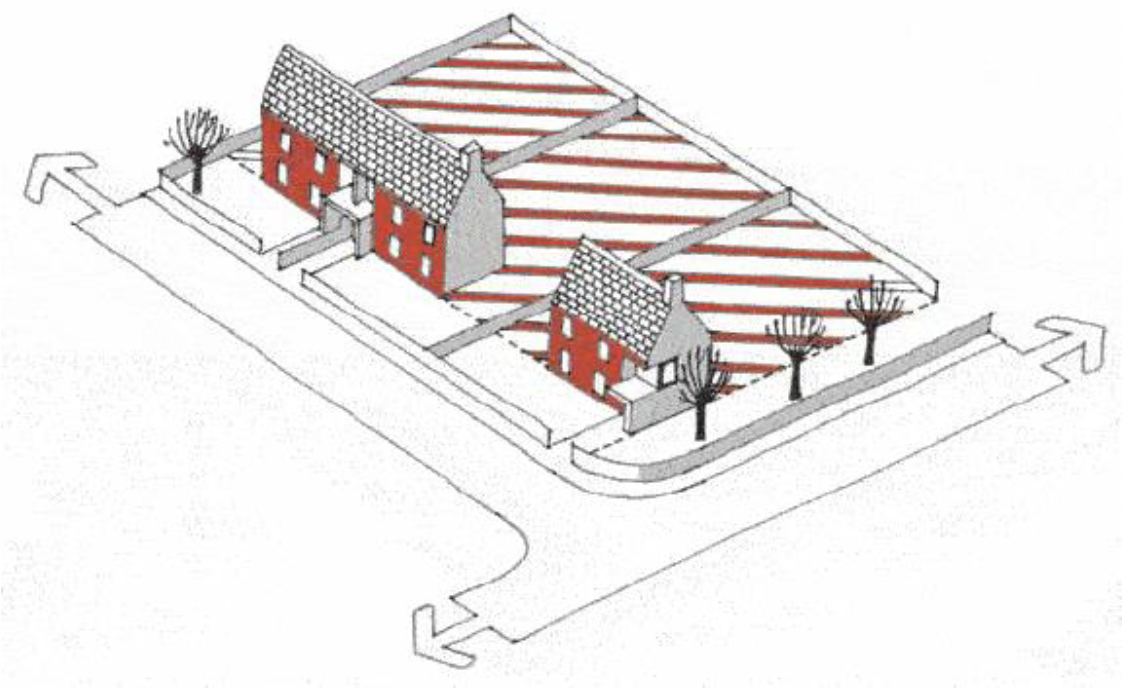
4.74 The development cannot be higher than 3 metres. When measuring the height of the development on sloping or uneven ground, the height should be measured from the lowest point immediately adjacent to the development.
4.75 The proposed development and existing developments (including extensions, sheds, garages etc.) cannot exceed half of the rear curtilage (or front if appropriate) curtilage of the original dwellinghouse. See section 3.
4.76 The following types of development are not permitted by this class, as these types of developments are permitted by other classes:
- Ancillary buildings (Class 3A)
- Hard surfaces (Class 3C)
- Decking (Class 3D)
- Gates, fences, walls or other means of enclosure (Class 3E)
- Ground source heat pumps (Class 6D)
- Water source heat pumps (Class 6E)
- Free-standing wind turbines (Class 6G)
- Air source heat pumps (Class 6H)
- Roof-mounted solar panels (Class 6HA)
- Means of access (Class 8)
Legislation
Class 3B.-
(1) The carrying out of any building, engineering, installation or other operation within the curtilage of a dwellinghouse for any purpose incidental to the enjoyment of that dwellinghouse.
Development is not permitted by this class if-
(a) any part of the development would be forward of a wall forming part of the principal elevation or side elevation where that elevation fronts a road;
(b) any resulting structure would exceed 3 metres in height;
(c) as a result of the development the area of ground covered by development within the front or rear curtilage of the dwellinghouse (excluding the original dwellinghouse and any hard surface or deck) would exceed 50% of the area of the front or rear curtilage respectively (excluding the ground area of the original dwellinghouse and any hard surface or deck);
(d) it would be within a conservation area or within the curtilage of a listed building; or
(e) it would be development described in Class 3A(1), 3C(1), 3D(1), 3E(1), 6D, 6E, 6G(1), 6H(1), 6HA(1) or 8.
Hard surfaces (Class 3C)
4.77 PDR under Class 3C allow the construction or replacement of a hard surface within the curtilage of a dwellinghouse. If the hard surface exceeds any of the following limits then an application for planning permission is required.
4.78 If the hard surface is located between the dwellinghouse and a road, then it must be constructed of a porous material or that provision is made for surface water run off to be directed to a porous area within the curtilage of the dwellinghouse.
4.79 Planning permission is required for a hard surface in conservation areas and in the curtilage of listed buildings. A building warrant from the local authority may be required, as explained in section 2. Planning authorities will be able to confirm whether a property is located within a conservation area. Information on listed buildings is available on Historic Environment Scotland’s website.
Legislation
Class 3C.-
(1) The provision within the curtilage of a dwellinghouse of a hard surface for any purpose incidental to the enjoyment of that dwellinghouse or the replacement in whole or in part of such a surface.
(2) Development is not permitted by this class if it would be within a conservation area or within the curtilage of a listed building.
(3) Development is permitted by this class subject to the condition that where the hard surface would be located between the dwellinghouse and a road bounding the curtilage of the dwellinghouse-
(a) the hard surface must be made of porous materials; or
(b) provision must be made to direct run off water from the hard surface to a permeable or porous area or surface within the curtilage of the dwellinghouse.
Decking or other raised platform (Class 3D)
Summary
4.80 PDR allow the erection, construction, maintenance, improvement or alteration of any deck or other raised platform within the curtilage of a dwellinghouse. In summary, the effect of the limitations is that:
- decks are generally located to the rear.
- the height of the floor level does not exceed 0.5 metre.
- the total height of the deck, including any attached structure does not exceed 2.5 metres.
4.81 If the deck, or raised platform, is in a conservation area or within the curtilage of listed building the maximum size of the deck, or raised platform, is 4 square metres. There are no Class 3D PDR for flats or for a dwellinghouse created by Class 18B or 22A (i.e. conversion of an agricultural or forestry building).
4.82 A building warrant from the local authority may be required for the deck or other raised platform, as explained in section 2.
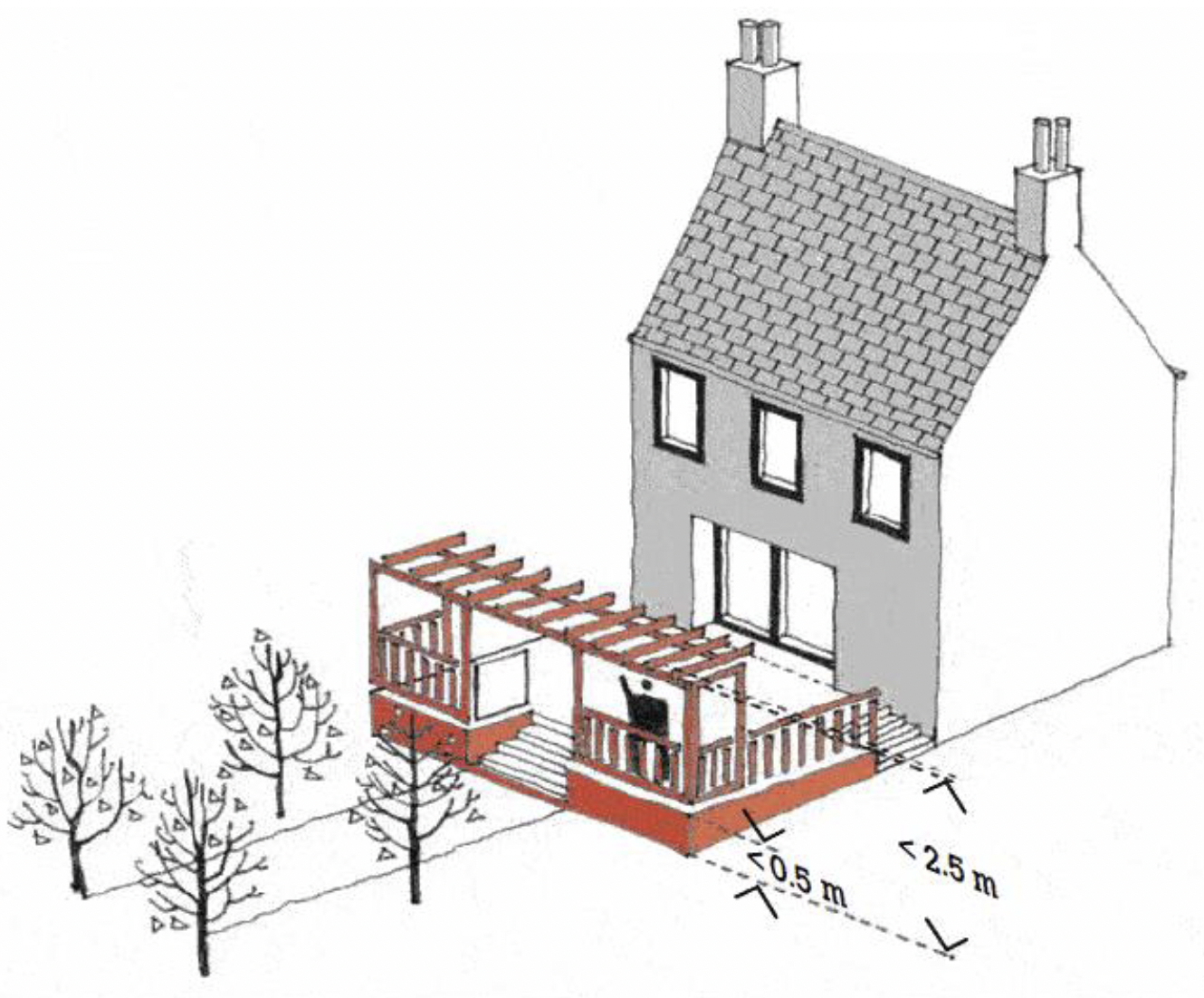
Technical Explanation
4.83 If the deck, or raised platform, exceeds any of the following limits then an application for planning permission is required.
4.84 Decks cannot be forward of a wall forming part of the principal elevation or side elevation if that elevation is fronting a road. The identification of the principal elevation and side elevations are discussed in section 3 of this guidance, as is the concept of fronting a road. This is illustrated below, the shaded areas of the curtilage indicate where an extension is permitted as long as the other limitations are met.

4.85 The maximum height of the platform of the decking is 0.5 metre. The total height if, for example screens are attached, is 2.5 metres. When measuring the height of the deck on sloping or uneven ground, the height should be measured from the lowest point immediately adjacent to the decking.
4.86 The size of decking in conservation areas and within the curtilage of listed buildings is restricted to 4 square metres to be permitted development. Planning authorities will be able to confirm whether a property is located within a conservation area. Information on listed buildings is available on Historic Environment Scotland’s website.
Legislation
Class 3D.-
(1) The erection, construction, maintenance, improvement or alteration of any deck or other raised platform within the curtilage of a dwellinghouse for any purpose incidental to the enjoyment of that dwellinghouse.
Development is not permitted by this class if-
(za) the dwellinghouse is a dwelling by virtue of a change of use permitted under Class 18B or 22A;
(a) any part of the development would be forward of a wall forming part of the principal elevation or side elevation where that elevation fronts a road;
(b) the floor level of any part of the deck or platform would exceed 0.5 metres in height;
(c) the combined height of the deck and any wall, fence, balustrade, handrail or other structure attached to it, would exceed 2.5 metres; or
(d) in the case of land within a conservation area or within the curtilage of a listed building the deck or platform would have a footprint exceeding 4 square metres.
Gates, fences and walls (Class 3E)
4.87 PDR under Class 3E allow the erection, construction, maintenance, improvement or alteration of any gate, fence, wall or other means of enclosure.
4.88 If the gate, fence, wall or other means of enclose exceeds the following limits then an application for planning permission is required.
4.89 The maximum height of any gate, fence, wall or other means of enclosure is 2 metres. Whilst its maximum height 1 metre if it fronts a road (explained in section 3 of this guidance) or comes forward of the principal elevation or side elevation nearest a road. Identifying the principal elevation is also explained in section 3.
4.90 When measuring the height of the development on sloping or uneven ground, the height should be measured from the lowest point immediately adjacent to the gate, fence, wall or other means of enclosure.
4.91 The replacement or alteration of an existing gate, fence, wall or other means of enclosure to its original height is permitted. For example, an existing 1.2 metre fence forward of the principal elevation can be replaced with a fence up to 1.2 metres in height. If the replacement fence is higher than 1.2 metres then an application for planning permission would be required. Alternatively, if replacing a 0.8 metre high fence forward of the principal elevation it can be replaced by with a fence up to 1 metre in height.
4.92 Planning permission is needed for gates, fences, wall or other mean of enclosure in conservation areas and in the curtilage of listed buildings. Planning authorities will be able to confirm whether a property is located within a conservation area. Information on listed buildings is available on Historic Environment Scotland’s website.
Legislation
Class 3E.-
(1) The erection, construction, maintenance, improvement or alteration of any gate, fence, wall or other means of enclosure any part of which would be within or would bound the curtilage of a dwellinghouse.
Development is not permitted by this class if-
(a) any part of the resulting gate, fence, wall or other means of enclosure would exceed 2 metres in height;
(b) any part of the resulting gate, fence, wall or other means of enclosure would exceed one metre in height where it-
(i) fronts a road; or
(ii) extends beyond the line of the wall of the principal elevation or side elevation that is nearest a road;
(c) it replaces or alters an existing gate, fence, wall or other means of enclosure and exceeds whichever is the greater of the original height or the heights described in sub-paragraphs (a) and (b);
(d) it would be within a conservation area; or
(e) it would be within, or bound, the curtilage of a listed building.
Contact
Email: Chief.Planner@gov.scot
There is a problem
Thanks for your feedback